The value of data has been vastly underestimated. Additionally, it’s sometimes viewed as “out of sight, out of mind” – until a data breach happens.
So, how can this be rectified?
Cue the CFO. You might think this is something the CIO should manage. And, you would be partly correct. However, the CFO needs hands-on involvement in how, when, why, and what is being invested in technology.
Data as an essential asset should be important enough to a line item on the balance sheet. This creates visibility to the organization and the value that the CFO has placed on the data.

In this “Back @ IT” episode, I’m joined by Jason Yaeger, CEO of Tenacity Cloud. We chat about security, privacy, value, and the importance of the CFO’s role in creating a culture to value data.
Highlights
02:03: Jason outlines his 25-year experience in technology. He has worked with the healthcare and financial industries. Additionally, he has led teams as Operations Manager, VP of Operations and Product Development, and Chief Security and Revenue Officer.
06:26: Security should be viewed holistically. Previously, a focus on just the ingress or egress of legacy on-premise systems was more simplistic. However, the points of access have increased dramatically.
09:51: Web-enabled devices are everywhere. But, do they all make sense? Do we need AI-infused smokers or grills?
If the CFO can’t assign value to their data…then it’s not very easy to justify spending money on securing it.
Jason Yaeger | CEO, Tenacity
13:15: Many times there is a false sense of security that’s pervasive through an organization. This can lead to bad decisions and costly fines for non-compliance.
15:22: More than 25% – actually closer to 50% – of data breaches are the result of infrastructure mistakes. The goal of Tenacity is to help companies focus on proactive security.
18:21: Data privacy laws and compliance regulations are forcing companies to make data a central asset. If a company were to violate a GDPR rule and is fined, that means the data has value. But, if it’s not on the balance sheet, then it’s not visible.
21:39: Business leaders are asking the wrong questions. Instead of asking, “How much does this cost?”, decision-makers should be asking, “If we don’t do this, what are we saying ‘No’ to?” The investment to mitigate the risk is far less costly than the outcome of a data breach.
25:19: Security shouldn’t be viewed as a hindrance to the business objectives. For example, if your company processes credit cards from customer purchases, you need to be PCI compliant. If you aren’t compliant, this can be a loss of business from customers and vendors.
Alignment in the top top level leadership – the CIO, CFO, and CEO – plays a critical role. And, the CFO needs to make it known, “Anything from a security perspective needs to be brought to my desk”.
33:42: It’s critical that CFOs implement accounting rules to further assign value to the data. However, this is only one part of the solution. The other part is to create a culture to value data. This helps investors, employees, and customers realize that the data is not valueless.
36:50: Insurance for data does help somewhat. But, unlike a physical item that could be stolen, if data is stolen, it can’ be undone – it’s permanent. And, the increase in ransomware attacks should be a wake-up call to start placing greater value on company data.
Tenacity Cloud is to help companies mitigate security threats, fix misconfigurations, and manage cloud spend from one intuitive platform.
- Cloud Asset Management: Delivers comprehensive visibility across all your deployed resources.
- Security Posture: Provides real time insights of your Cloud Security Posture Management (CSPM). This is analyzed from workloads, networks, user activity, data and configurations to prioritize and remediate threats to your cloud.
- Budget Intelligence: Get immediate, detailed access to current and past cloud spend so you know where it’s going.
- Compliance Monitoring: Track compliance scores over time, identify open issues immediately and track your teams progress towards remediation.







